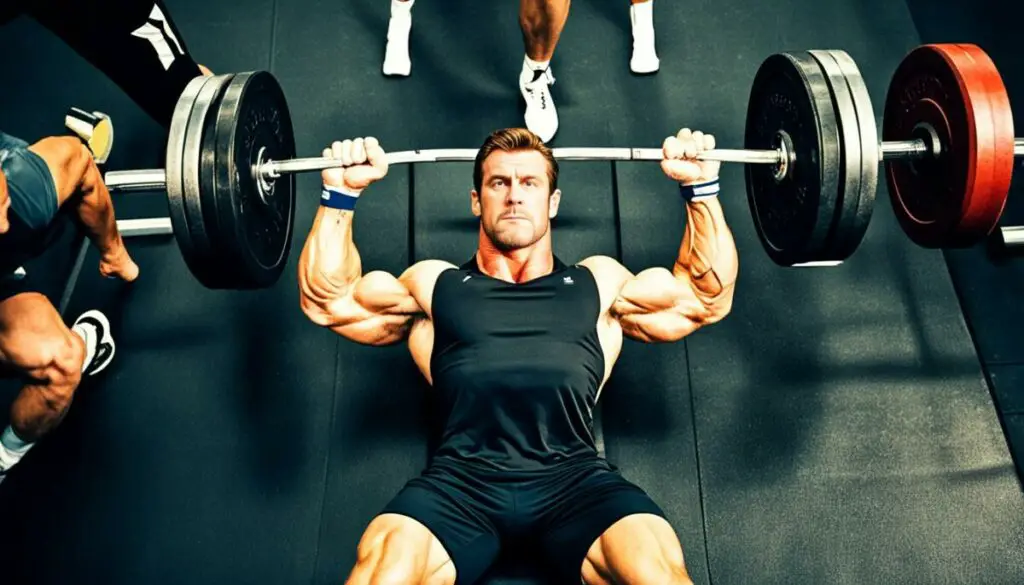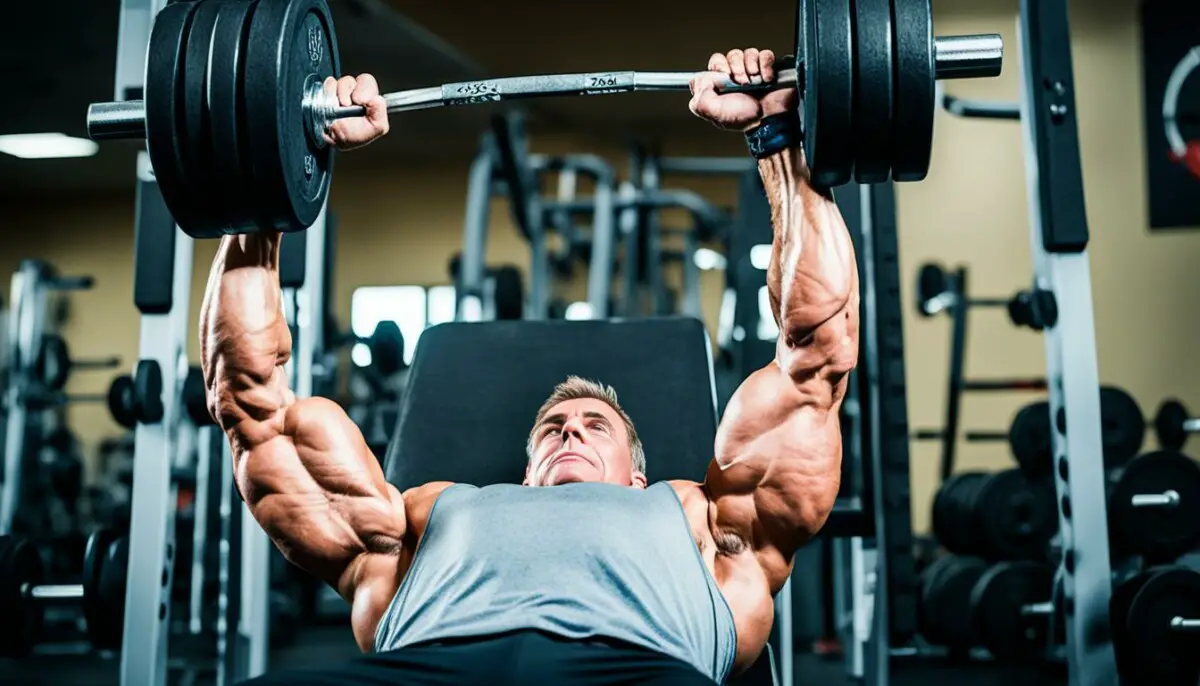Last Updated on 3 months by Francis
The dumbbell vs barbell bench press is a popular debate among fitness enthusiasts. While both exercises target the chest muscles, they have distinct differences in terms of difficulty and benefits. Let’s explore the comparison between dumbbell and barbell bench presses to see which one is tougher.
Contents
The Benefits of Barbell Bench Press
The barbell bench press is a highly effective exercise that offers numerous advantages for muscle development and strength building. Whether you are a seasoned lifter or just starting your fitness journey, incorporating the barbell bench press into your workout routine can yield significant benefits.
Advantages of Using Dumbbells for Bench Press
Before we dive into the benefits of the barbell bench press, it’s important to understand the advantages of using dumbbells for bench press workouts. Dumbbell bench press exercises provide a greater range of motion and help to activate stabilizing muscles, resulting in improved balance and coordination. Additionally, dumbbell bench press allows for unilateral training, addressing any strength imbalances between your left and right sides.
However, the barbell bench press offers distinct advantages that make it a valuable addition to any strength training regimen.
- Effective Progressive Overload: The barbell bench press allows for progressive overload in a more controlled and measurable manner. By gradually increasing the weight on the barbell, you can consistently challenge your muscles and stimulate muscle growth.
- Focused Pectoral Muscle Activation: The barbell bench press primarily targets the pectoral muscles (chest), providing an intense workout for this muscle group. The stability of the barbell allows for a more focused and concentrated effort on the chest muscles, leading to enhanced development.
- Beginner-Friendly: The setup for the barbell bench press is relatively straightforward, especially when using a bench press rack. This makes it an accessible exercise for beginners who are just starting their fitness journey.
The barbell bench press allows for effective progressive overload, allowing you to focus on the pecs and enhance muscle growth.
Furthermore, the barbell bench press can be easily modified by adjusting grip width or using an incline or decline bench to target different areas of the chest and upper body. This versatility allows for a varied and challenging workout that can be tailored to your specific goals.
Making the Most of Your Barbell Bench Press
To optimize your barbell bench press workouts, it’s essential to prioritize proper form and technique. Here are some tips to help you get the most out of this exercise:
- Ensure a stable grip on the barbell, keeping your wrists in a neutral position.
- Engage your core and maintain a strong, stable body position throughout the movement.
- Lower the barbell in a controlled manner, focusing on keeping tension in your chest muscles.
- Drive the barbell upward explosively, using the power of your chest muscles while maintaining control.
- Gradually increase the weight over time to continue challenging your muscles and promoting growth.
By following these guidelines, you can maximize the benefits of the barbell bench press and achieve the results you desire.
| Advantages of Barbell Bench Press | Dumbbell Bench Press |
|---|---|
| Allows for effective progressive overload | Provides a greater range of motion |
| Targets the pecs for enhanced muscle growth | Activates stabilizing muscles for improved balance |
| Beginner-friendly and easy to set up | Addresses strength imbalances with unilateral training |
Incorporate Barbell Bench Press into Your Routine
Whether your goal is to build strength, increase muscle size, or improve overall fitness, the barbell bench press is an exercise that can deliver excellent results. Consider incorporating this compound movement into your chest workouts to challenge your muscles and achieve your desired outcomes.
Remember, it’s always important to consult with a fitness professional or trainer and listen to your body to ensure proper form and prevent injury. Start with a weight that challenges you but allows for proper technique, and gradually increase the load as you become more comfortable and stronger.
The Advantages of Dumbbell Bench Press

The dumbbell bench press offers a variety of advantages that make it a valuable addition to any strength training routine.
Engages a wider range of muscles:
The dumbbell bench press requires each arm to work independently, engaging additional stabilizer muscles in the shoulders and core. This helps improve balance and stability, promoting functional strength that translates into everyday activities.
Prevents training imbalances:
Because each arm works independently, the dumbbell bench press can help identify and address any strength imbalances between the right and left sides of the body. By targeting each arm individually, you can ensure that both sides develop strength and size evenly, reducing the risk of injuries caused by muscle imbalances.
Allows for a more natural range of motion:
Unlike the barbell bench press, which limits your range of motion to a fixed bar path, the dumbbell bench press allows for a more natural movement. This can be particularly beneficial for individuals with shoulder or mobility issues, as it reduces the strain on the joints and allows for a greater range of motion.
The dumbbell bench press offers endless possibilities for variations and modifications. By adjusting the angle of the bench or incorporating different grip positions, you can target specific areas of the chest and shoulders, stimulating muscle growth and promoting overall upper body strength.
However, it’s important to note that the dumbbell bench press may be more challenging to perform initially, as it requires greater coordination and stability compared to the barbell bench press. Proper form and technique are crucial to maximize the benefits and reduce the risk of injury.
To perform a dumbbell bench press:
- Lie flat on a bench with a dumbbell in each hand, held at shoulder level.
- Lower the dumbbells slowly and controlled to the sides of your chest, keeping the elbows at a 45-degree angle.
- Push the dumbbells up explosively until your arms are fully extended, but without locking out your elbows.
- Repeat for the desired number of repetitions.
Remember: Always start with a weight that allows you to maintain proper form throughout the exercise. Gradually increase the weight as you become more comfortable and confident with the movement.
The Difference in Weight Pressed

When comparing the dumbbell bench press and the barbell bench press, one noticeable difference is the amount of weight that lifters can press. Research suggests that individuals can generally handle approximately 20% more weight when using a barbell compared to dumbbells.
This variation in weight capacity between the two exercises can be attributed to the shape and mechanics of the barbell. The straight, fixed position of the barbell allows for a more focused emphasis on the pectoral muscles and facilitates easier overload. In contrast, the dumbbell bench press requires greater effort to balance and control the individual weights, making it a more challenging exercise to complete.
For those looking to make the dumbbell bench press easier, there are a few tips that can help enhance performance and alleviate some of the difficulty:
- Start with lighter weights: Begin your dumbbell bench press workouts using lighter weights that can be comfortably controlled. This allows for proper form and technique while gradually building strength and stability.
- Focus on proper form and technique: Pay attention to your body positioning, grip, and range of motion during the exercise. Engage the muscles of your chest, shoulders, and arms while maintaining stability throughout the movement.
- Strengthen supporting muscles: Incorporate exercises that target the muscles involved in stabilizing the dumbbell bench press, such as the triceps, core, and upper back. Strengthening these muscles can improve overall stability and control during the exercise.
- Use assistance or modifications: If the dumbbell bench press remains challenging despite proper form and gradual progression, consider using assistance tools like resistance bands or performing the exercise on an incline bench. These modifications can help reduce the load and make the exercise more manageable.
By incorporating these strategies, individuals can make the dumbbell bench press more accessible and gradually progress to higher weights over time.
Muscle Activation

Muscle activation plays a significant role in determining the effectiveness of different exercises. When comparing the dumbbell and barbell bench presses, it’s essential to understand how each exercise activates different muscles.
The dumbbell bench press primarily targets the pectoralis major (pecs) and the anterior deltoids (front delts) similar to the barbell bench press. However, due to the arc-like movement of the dumbbells and the need to stabilize them independently, the dumbbell bench press activates the biceps more than the triceps.
The barbell bench press, on the other hand, requires more triceps activation to control the movement of the barbell. This added triceps activation can be advantageous for individuals aiming to develop overall arm strength and size.
To summarize, while both exercises primarily work the chest and front deltoids, the dumbbell bench press places slightly more emphasis on the biceps compared to the triceps, with the opposite being true for the barbell bench press.
For a visual representation of the muscle activation patterns, refer to the table below:
| Exercise | Muscle Activation |
|---|---|
| Dumbbell Bench Press | Primary: Pectoralis Major (pecs), Anterior Deltoids (front delts) Secondary: Biceps |
| Barbell Bench Press | Primary: Pectoralis Major (pecs), Anterior Deltoids (front delts) Secondary: Triceps |
As seen in the table, the dumbbell bench press recruits the biceps to a greater extent, while the barbell bench press emphasizes triceps activation. Understanding these differences in muscle activation can help you tailor your training routine to your specific goals and target muscle groups effectively.
Tips for Effective Bench Pressing

To optimize your dumbbell bench pressing, it’s essential to focus on proper form and technique. By following these tips, you can improve your performance and make the exercise more manageable.
- Maintain a stable grip: Hold the dumbbells firmly with a neutral grip, ensuring that your wrists are aligned with your forearms. This grip will provide stability throughout the movement.
- Engage your entire body: It’s crucial to engage your core, glutes, and leg muscles to create a solid foundation and maintain stability. This full-body engagement will also help you lift heavier weights.
- Use a controlled tempo: Avoid using momentum to lift the dumbbells. Instead, focus on a slow and controlled tempo, emphasizing the eccentric (downward) phase of the movement. This controlled descent will engage your muscles more effectively.
- Start with lighter weights: If you’re new to dumbbell bench pressing or want to work on your form, start with lighter weights. Gradually increase the load as you become more comfortable with the exercise and build strength.
- Consider variations: Incorporating different variations of the dumbbell bench press, such as incline or decline bench presses, can target different areas of the chest and challenge your muscles in new ways. This variety will help prevent plateaus and keep your workouts exciting.
- Combine with barbell bench press: Combining both dumbbell and barbell bench presses in your training routine can provide additional benefits. The barbell bench press allows for greater weightlifting potential, while the dumbbell bench press engages multiple muscles for stability and functional strength.
By implementing these tips, you can improve your dumbbell bench pressing technique, make the exercise more manageable, and achieve better results in your chest workouts.
The Order of Bench Press Exercises

When it comes to planning your chest workouts, the order of bench press exercises can have a significant impact on your results. Experts recommend starting with barbell bench presses before moving on to dumbbell presses. This sequencing allows you to maximize the amount of weight lifted and increase overload on the chest muscles, leading to improved strength and muscle growth.
The barbell bench press is often performed first because it allows you to handle heavier weights compared to the dumbbell bench press. By starting with the barbell, you can focus on lifting the maximum amount of weight and effectively target your chest muscles. This exercise also engages other muscle groups, such as the triceps and shoulders, as secondary movers.
After completing your barbell bench press sets, it’s time to transition to dumbbell presses. Dumbbell bench presses offer several advantages, including increased stability and the ability to target individual muscles more effectively. By using dumbbells, you can isolate and concentrate on the pectoral muscles without relying on the triceps as the weak link.
This order of bench press exercises allows for balanced muscle development and effective progression. By starting with the barbell bench press, you can focus on building overall strength and gradually increase the weight lifted. Then, by transitioning to dumbbell presses, you can further target and engage the chest muscles for a more complete and well-rounded workout.
“Starting with the barbell bench press allows you to lift heavier weights and overload your chest muscles effectively. Transitioning to dumbbell presses afterwards helps prevent muscle imbalances and further targets the pecs without relying on triceps strength.”
Whether you’re aiming to increase strength or build muscle, incorporating both barbell and dumbbell bench presses in your training routine can yield significant benefits. Remember to always maintain proper form and consult with a fitness professional to ensure you’re performing the exercises correctly.
Comparison of Barbell and Dumbbell Bench Press
| Barbell Bench Press | Dumbbell Bench Press | |
|---|---|---|
| Difficulty | Easier to balance and lift heavier weights | Requires more effort for balancing, limiting weight lifted |
| Muscle Activation | Engages pecs, triceps, and shoulders | Targets pecs without relying on triceps |
| Range of Motion | Restricted by the barbell’s fixed path | Allows for a wider range of motion |
| Stability | Stable setup with a rack | Requires individual stability and balance |
| Variability | Limited to flat, incline, and decline variations | Allows for more versatility and variations |
The Importance of Consultation
Before starting any exercise or nutrition program, it is crucial to consult with a physician or healthcare professional to ensure your safety and well-being. This is especially important for individuals with pre-existing health conditions or those over the age of 35. Better safe than sorry! By seeking professional advice, you can assess your current physical condition and identify any potential limitations or risks that may affect your ability to perform certain exercises.
When it comes to the dumbbell bench press, consulting with a healthcare professional becomes even more essential. This exercise involves lifting weights and placing stress on your chest muscles and the supporting structures of your shoulders. It is important to ensure that you are physically prepared and capable of performing this exercise without compromising your health.
“Consultation is the key to a successful fitness journey. Your healthcare professional can provide valuable insights and guidance specific to your individual needs, helping you make informed decisions about incorporating the dumbbell bench press into your workout routine.”
During your consultation, be sure to discuss any existing injuries or conditions that may impact your ability to perform the dumbbell bench press safely. Your healthcare professional can provide specific recommendations and modifications to accommodate your unique circumstances.
Keep in mind that while the dumbbell bench press offers various benefits, it may not be suitable for everyone. Individuals with certain shoulder or chest conditions, such as rotator cuff injuries or pectoral muscle strains, may need to avoid or modify this exercise. Your healthcare professional can help you determine the best course of action based on your individual needs and limitations.
Remember, safety should always be a priority when engaging in physical activity. Listen to your body and seek medical advice if you experience any abnormal symptoms or discomfort during your workouts. By consulting with a healthcare professional, you can ensure that the dumbbell bench press and other exercises you perform are safe, effective, and aligned with your fitness goals.
The Influence of Equipment and Variations
The choice between dumbbell and barbell bench presses can be influenced by personal preference, goals, and available equipment. Both options provide unique advantages that cater to different individuals and training styles. Experimenting with various dumbbell bench press variations can help target specific muscle groups and enhance overall workout effectiveness.
When it comes to dumbbell bench press variations, incorporating incline or decline bench presses can yield different muscle activation and stimulate diverse areas of the chest. Incline dumbbell bench presses primarily target the upper chest, while decline dumbbell bench presses focus more on the lower chest. By incorporating these variations into your routine, you can effectively develop your chest muscles from various angles.
In addition to variations, incorporating other chest exercises like machine presses can offer additional benefits to your training routine. Machine presses provide a controlled movement pattern and can isolate the chest muscles, allowing for a heavy load without the need for balancing dumbbells or a barbell. These exercises can help prevent monotony in your routine while still targeting the chest muscles.
“By incorporating different dumbbell bench press variations and incorporating other chest exercises, individuals can experience greater muscle stimulation, prevent plateaus, and keep their workouts engaging and enjoyable.”
It’s important to note that the advantages of using dumbbells for bench press extend beyond variations. Dumbbells require a greater level of stability and coordination as each arm works independently. This engages a wider range of muscles, including stabilizer muscles, resulting in improved functional strength. Additionally, dumbbells allow for a more natural range of motion, reducing the risk of injury and promoting better joint health.
Comparison of Dumbbell and Barbell Bench Presses
| Factors | Dumbbell Bench Press | Barbell Bench Press |
|---|---|---|
| Weight Lifted | Lower weight lifted due to balancing requirement | Higher weight lifted due to stability from the barbell |
| Muscle Activation | Engages a wider range of muscles for balance and stability | Primarily targets the pecs and front delts |
| Range of Motion | Allows for a more natural range of motion | May have limited range due to the barbell |
| Progressive Overload | Requires incremental increases in dumbbell weight | Allows for larger weight incrementation |
By considering the influence of equipment, variations, and incorporating other exercises, you can create a well-rounded chest workout routine that suits your goals and preferences. It’s important to find a balance between challenging yourself and maintaining proper form to maximize the benefits of each exercise.
Key Takeaways
When comparing dumbbell and barbell bench presses, it’s important to consider their respective advantages and challenges. The barbell bench press allows for effective progressive overload and is beginner-friendly, while the dumbbell bench press engages multiple muscles for functional strength.
Here are the key takeaways:
- Advantages of Barbell Bench Press: The barbell bench press enables effective progressive overload, making it ideal for building strength and seeing quick progress. It also targets the pecs and enhances muscle growth.
- Advantages of Dumbbell Bench Press: The dumbbell bench press engages a wider range of muscles to maintain balance and stability, promoting functional strength. It also allows for a more natural range of motion and prevents training imbalances.
The choice between the two exercises ultimately depends on individual goals and preferences. To maximize results:
- Prioritize proper form and technique for both exercises.
- Consult with a healthcare professional before starting any exercise program, especially if you have pre-existing health conditions.
- Vary your training routine by incorporating both dumbbell and barbell bench presses, and explore different variations like incline or decline bench presses.
By following these recommendations, you can optimize your bench press workouts and achieve your fitness goals.
| Advantages | Challenges | |
|---|---|---|
| Barbell Bench Press | Allows for effective progressive overload Targets pecs and enhances muscle growth |
Setup is easier with a rack Beginner-friendly exercise |
| Dumbbell Bench Press | Engages multiple muscles for functional strength Prevents training imbalances |
Requires more effort to balance weights May not yield as much pec development |
Conclusion
In the battle of dumbbell vs barbell bench press, there is no definitive winner. Each exercise offers its own set of advantages and challenges, catering to different fitness goals and preferences.
The barbell bench press allows for greater overload and easier execution, making it an excellent choice for beginners and individuals looking to make rapid progress. It focuses on the pecs and enhances muscle growth, providing a solid foundation for building strength.
On the other hand, the dumbbell bench press engages a wider range of muscles, promoting functional strength and stability. It requires more effort and skill to balance the weights, challenging the body in a different way. While it may not yield as much pec development as the barbell bench press, it offers versatility and helps prevent training imbalances.
In the end, it comes down to personal preference and individual fitness goals. Whether you choose the barbell or dumbbell bench press, both exercises have their place in a well-rounded training routine. Consider incorporating variations and consulting with a healthcare professional to ensure proper form and safety. Remember, what matters most is consistency, dedication, and finding the exercise that brings you closer to your fitness goals.
FAQ
Is the dumbbell bench press harder than the barbell bench press?
The dumbbell bench press can be more challenging due to the need to balance the weights, making it a harder exercise to complete compared to the barbell bench press.
What are the benefits of the barbell bench press?
The barbell bench press allows for effective progressive overload, focusing on the pecs and enhancing muscle growth. It is beginner-friendly and ideal for building strength and seeing quick progress.
What advantages does the dumbbell bench press offer?
The dumbbell bench press engages a wider range of muscles to maintain balance and stability, promoting functional strength. It also prevents training imbalances and allows for a more natural range of motion.
How does the weight pressed differ between dumbbell and barbell bench presses?
Research shows that lifters can generally press 20% more weight with a barbell compared to dumbbells. The shape of the barbell allows for greater focus on the pecs, making it easier to overload the muscles.
How does muscle activation differ between dumbbell and barbell bench presses?
While both exercises primarily target the pecs and front delts, the dumbbell bench press involves less triceps activation and more biceps activation due to the arc-like movement of the dumbbells.
What are some tips for effective bench pressing?
To optimize your bench pressing, focus on proper form and technique. Maintain a stable grip on the dumbbells, engage the entire body for stability, and use a controlled tempo. Start with lighter weights and gradually increase the load to build strength.
What is the recommended order of bench press exercises?
Many experts recommend starting with barbell bench presses to maximize weight lifted and increase overload on the chest muscles. Afterward, move on to dumbbell presses to target the pecs without relying on triceps as the weak link, thus promoting balanced muscle development and effective progression.
How important is consultation before starting a bench press routine?
It is crucial to consult with a physician or healthcare professional, especially for individuals with pre-existing health conditions or those over the age of 35, before starting any exercise or nutrition program. Safety should always be a priority when engaging in physical activity.
How can equipment and variations influence bench press workouts?
The choice between dumbbell and barbell bench presses can be influenced by personal preference, goals, and available equipment. Incorporating variations such as incline or decline bench presses can target specific muscle groups. Additionally, incorporating other exercises like machine presses can provide additional benefits and prevent monotony in your training routine.
What are the key takeaways from the dumbbell vs. barbell bench press comparison?
The barbell bench press allows for effective progressive overload and is beginner-friendly, while the dumbbell bench press engages multiple muscles for functional strength. The choice depends on individual goals and preferences.
Is there a clear winner in the dumbbell vs. barbell bench press debate?
There is no clear winner as both exercises offer unique benefits and challenges. The barbell bench press allows for greater overload and is easier to perform, making it suitable for beginners and those seeking rapid progress. The dumbbell bench press promotes functional strength and engages a wider range of muscles but may require more effort and skill.








